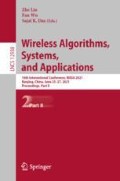Abstract
Unmanned Aerial Vehicle (UAV) swarm has been widely applied in border surveillance, public safety, transportation management and so on. Affected by the complex mission environment and rapidly changing network topology, the network performance decreases drastically especially when an unsuitable contention window size is selected in traditional media access control (MAC) protocol. In this work, we first introduce a node-counts-based UAV swarm MAC (NCU_MAC) protocol to dynamically adjust the contention window size according to the number of neighbor nodes. Next, a four- dimensional Markov Chain model is developed to model the media access process and evaluate the performance of NCU_MAC. The expressions of the collision, transmission probability and saturation throughput are obtained theoretically. Simulation results are presented to validate the effectiveness of the proposed model and show the saturation throughput of the swarm network in the process of cooperative movement.
Access this chapter
Tax calculation will be finalised at checkout
Purchases are for personal use only
References
Bianchi, G.: Performance analysis of the IEEE 802.11 distributed coordination function. IEEE J. Sel. Areas Commun. 18(3), 535–547 (2000). https://doi.org/10.1109/49.840210
Brown, T.X., Argrow, B., Dixon, C., Doshi, S., Henkel, D.: Ad hoc UAV Ground Network (AUGNet). In: AIAA 3rd “Unmanned Unlimited” Technical Conference, Workshop and Exhibit, vol. 6321 (2004)
Ruan, Y., Zhang, Y., Li, Y., Zhang, R., Hang, R.: An adaptive channel division MAC protocol for high dynamic UAV networks. IEEE Sens. J. 20(16), 9528–9539 (2020). https://doi.org/10.1109/JSEN.2020.2987525
Patibandla, S.T., Bakker, T., Klenke, R.H.: Initial evaluation of an IEEE 802.11s-based mobile ad-hoc network for collaborative unmanned aerial vehicles. In: [C]//2013 International Conference on Connected Vehicles and Expo (ICCVE), pp. 145–150. IEEE (2013)
Al-Hubaishi, M., Alahdal, T., Alsaqour, R., Berqia, A., Abdelhaq, M., Alsaqour, O.: Enhanced binary exponential backoff algorithm for fair channel access in the ieee 802.11 medium access control protocol. Int. J. Commun. Syst. 27(12), 4166–4184 (2014)
Huang, D., Li, H., Li, X.: Formation of generic UAVs-USVs system under distributed model predictive control scheme. IEEE Trans. Circuits Syst. II Exp. Briefs 67(12), 3123–3127 (2020). https://doi.org/10.1109/TCSII.2020.2983096
Di, W., Caihong, L., Na, G., Yong, S., Tengteng, G., Guoming, L.: Local path planning of mobile robot based on artificial potential field. In: 2020 39th Chinese Control Conference (CCC), Shenyang, China, pp. 3677–3682 (2020). https://doi.org/10.23919/CCC50068.2020.9189250
Felemban, E., Ekici, E.: Single hop IEEE 802.11 DCF analysis revisited: accurate modeling of channel access delay and throughput for saturated and unsaturated traffic cases. IEEE Trans. Wireless Commun. 10(10), 3256–3266 (2011)
Tsertou, A., Laurenson, D.I.: Revisiting the hidden terminal problem in a CSMA/CA wireless network. IEEE Trans. Mob. Comput. 7(7), 817–831 (2008)
Garetto, M., Salonidis, T., Knightly, E.W.: Modeling per-flow throughput and capturing starvation in CSMA multi-hop wireless networks. IEEE/ACM Trans. Netw. 16(4), 864–877 (2008)
Acknowledgments
This work was supported in part by the National Natural Science Foundation of China (No. 61902182), the Natural Science Foundation of Jiangsu Province of China (No. BK20190409), the Aeronautical Science Foundation of China (No. 2016ZC52029), Qing Lan Project of Jiangsu Province of China, China Postdoctoral Science Foundation (No. 2019TQ0153), and the Foundation of CETC Key Laboratory of Aerospace Information Applications of China (No. SXX18629T022). The authors are with the College of Electronic and Information Engineering, Nanjing University of Aeronautics and Astronautics, Nanjing, 210016, China.
Author information
Authors and Affiliations
Corresponding author
Editor information
Editors and Affiliations
Rights and permissions
Copyright information
© 2021 Springer Nature Switzerland AG
About this paper
Cite this paper
Wang, J., Lei, L., Cai, S., Yan, M. (2021). Modeling the Instantaneous Saturation Throughput of UAV Swarm Networks. In: Liu, Z., Wu, F., Das, S.K. (eds) Wireless Algorithms, Systems, and Applications. WASA 2021. Lecture Notes in Computer Science(), vol 12938. Springer, Cham. https://doi.org/10.1007/978-3-030-86130-8_46
Download citation
DOI: https://doi.org/10.1007/978-3-030-86130-8_46
Published:
Publisher Name: Springer, Cham
Print ISBN: 978-3-030-86129-2
Online ISBN: 978-3-030-86130-8
eBook Packages: Computer ScienceComputer Science (R0)

